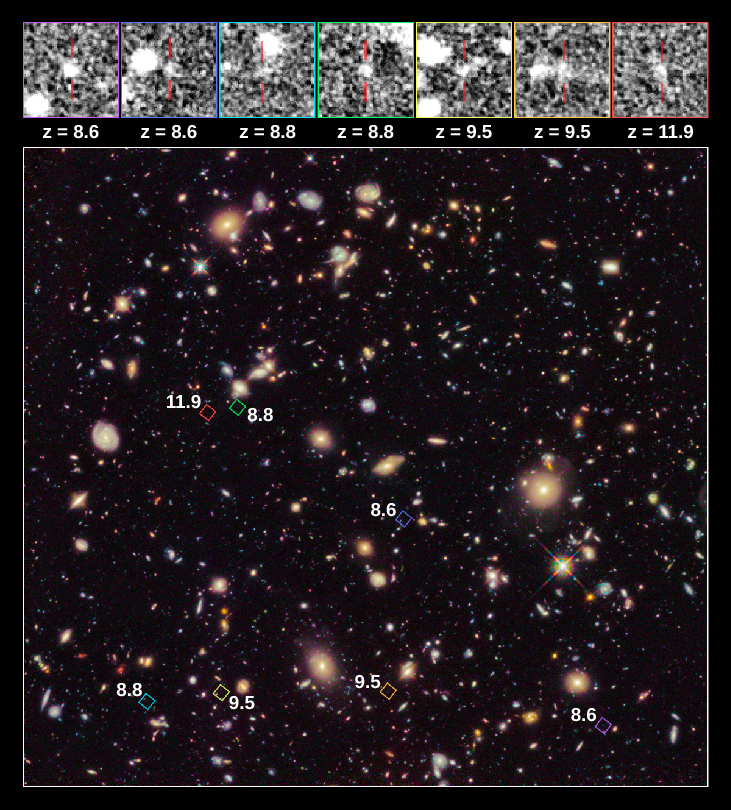| << Chapter < Page | Chapter >> Page > |
In the chapter on Galaxies , we discussed how we can use Hubble’s law to measure the distance to a galaxy. But that simple method only works with galaxies that are not too far away. Once we get to large distances, we are looking so far into the past that we must take into account changes in the rate of the expansion of the universe. Since we cannot measure these changes directly, we must assume one of the models of the universe to be able to convert large redshifts into distances.
This is why astronomers squirm when reporters and students ask them exactly how far away some newly discovered distant quasar or galaxy is. We really can’t give an answer without first explaining the model of the universe we are assuming in calculating it (by which time a reporter or student is long gone or asleep). Specifically, we must use a model that includes the change in the expansion rate with time. The key ingredients of the model are the amounts of matter, including dark matter, and the equivalent mass (according to E = mc 2 ) of the dark energy along with the Hubble constant.
Elsewhere in this book, we have estimated the mass density of ordinary matter plus dark matter as roughly 0.3 times the critical density, and the mass equivalent of dark energy as roughly 0.7 times the critical density. We will refer to these values as the “standard model of the universe.” The latest (slightly improved) estimates for these values and the evidence for them will be given later in this chapter. Calculations also require the current value of the Hubble constant. For [link] , we have adopted a Hubble constant of 67.3 kilometers/second/million parsecs (rather than rounding it to 70 kilometers/second/million parsecs), which is consistent with the 13.8 billion-year age of the universe estimated by the latest observations.
Once we assume a model, we can use it to calculate the age of the universe at the time an object emitted the light we see. As an example, [link] lists the times that light was emitted by objects at different redshifts as fractions of the current age of the universe. The times are given for two very different models so you can get a feeling for the fact that the calculated ages are fairly similar. The first model assumes that the universe has a critical density of matter and no dark energy. The second model is the standard model described in the preceding paragraph. The first column in the table is the redshift, which is given by the equation z = Δλ/λ 0 and is a measure of how much the wavelength of light has been stretched by the expansion of the universe on its long journey to us.
| Ages of the Universe at Different Redshifts | ||
|---|---|---|
| Redshift | Percent of Current Age of Universe When the Light Was Emitted (mass = critical density) | Percent of Current Age of Universe When the Light Was Emitted (mass = 0.3 critical density; dark energy = 0.7 critical density) |
| 0 | 100 (now) | 100 (now) |
| 0.5 | 54 | 63 |
| 1.0 | 35 | 43 |
| 2.0 | 19 | 24 |
| 3.0 | 13 | 16 |
| 4.0 | 9 | 11 |
| 5.0 | 7 | 9 |
| 8.0 | 4 | 5 |
| 11.9 | 0.02 | 0.027 |
| Infinite | 0 | 0 |
Notice that as we find objects with higher and higher redshifts, we are looking back to smaller and smaller fractions of the age of the universe. The highest observed redshifts as this book is being written are close to 12 ( [link] ). As [link] shows, we are seeing these galaxies as they were when the universe was only about 3% as old as it is now. They were already formed only about 700 million years after the Big Bang.

For describing the large-scale properties of the universe, a model that is isotropic and homogeneous (same everywhere) is a pretty good approximation of reality. The universe is expanding, which means that the universe undergoes a change in scale with time; space stretches and distances grow larger by the same factor everywhere at a given time. Observations show that the mass density of the universe is less than the critical density. In other words, there is not enough matter in the universe to stop the expansion. With the discovery of dark energy, which is accelerating the rate of expansion, the observational evidence is strong that the universe will expand forever. Observations tell us that the expansion started about 13.8 billion years ago.

Notification Switch
Would you like to follow the 'Astronomy' conversation and receive update notifications?